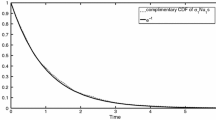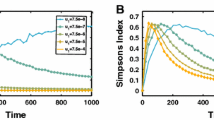Abstract
The multistage carcinogenesis hypothesis has been formulated by a number of authors as a stochastic process. However, most previous models assumed “perfect mixing” in the population of cells, and included no information about spatial locations. In this work, we studied the role of spatial dynamics in carcinogenesis. We formulated a 1D spatial generalization of a constant population (Moran) birth–death process, and described the dynamics analytically. We found that in the spatial model, the probability of fixation of advantageous and disadvantageous mutants is lower, and the rate of generation of double-hit mutants (the so-called tunneling rate) is higher, compared to those for the space-free model. This means that the results previously obtained for space-free models give an underestimation for rates of cancer initiation in the case where the first event is the generation of a double-hit mutant, e.g. the inactivation of a tumor-suppressor gene.
Similar content being viewed by others
Abbreviations
- TSG:
-
Tumor suppressor gene
- APC:
-
Adenomatous polyposis coli
- ODE:
-
Ordinary differential equation
References
Araujo, R., McElwain, D., 2004. A history of the study of solid tumor growth: The contribution of mathematical modeling. Bull. Math Biol. 66(5), 1039–1091.
Armitage, P., Doll, R., 1954. The age distribution of cancer and a multi-stage theory of carcinogenesis. Br. J. Cancer 8(1), 1–12.
Bellomo, N., Preziosi, L., 2000. Modeling and mathematical problems related to tumor evolution and its interation with the immune system. Math. Comp. Model. 22(3/4), 413–452.
Brown, C.C., Chu, K.C., 1983. Implications of the multistage theory of carcinogenesis applied to occupational arsenic exposure. J. Natl. Cancer Inst. 70(3), 455–463.
Chaplain, M., 1996. Avascular growth, angiogenesis and vascular growth in solid tumors. Math. Comp. Model. 23(6), 47–87.
Day, N.E., Brown, C.C., 1980. Multistage models and primary prevention of cancer. J. Natl. Cancer Inst. 64(4), 977–989.
Dewanji, A., Moolgavkar, S.H., Luebeck, E.G., 1991. Two-mutation model for carcinogenesis: Joint analysis of premalignant and malignant lesions. Math. Biosci. 104(1), 97–109.
Frank, S.A., 2005. Age-specific incidence of inherited versus sporadic cancers: A test of the multistage theory of carcinogenesis. Proc. Natl. Acad. Sci. U.S.A. 102(4), 1071–1075.
Gatenby, R.A., Vincent, T.L., 2003. An evolutionary model of carcinogenesis. Cancer Res. 63(19), 6212–6220.
Greaves, M., 2002. Cancer causation: The Darwinian downside of past success? Lancet Oncol. 3(4), 244–251.
Heidenreich, W.F., Luebeck, E.G., Moolgavkar, S.H., 1997. Some properties of the hazard function of the two-mutation clonal expansion model. Risk Anal. 17(3), 391–399.
Iwasa, Y., Michor, F., Nowak, M.A., 2004. Stochastic tunnels in evolutionary dynamics. Genetics 166(3), 1571–1579.
Knudson, A.G.J., 1971. Mutation and cancer: Statistical study of retinoblastoma. Proc. Natl. Acad. Sci. U.S.A. 68(4), 820–823.
Komarova, N.L., Sengupta, A., Nowak, M.A., 2003. Mutation-selection networks of cancer initiation: Tumor suppressor genes and chromosomal instability. J. Theor. Biol. 223(4), 433–450.
Komarova, N.L., Wang, L., 2004. Initiation of colorectal cancer: Where do the two hits hit? Cell Cycle 3(12), 1558–1565.
Komarova, N.L., Wodarz, D., 2004. The optimal rate of chromosome loss for the inactivation of tumor suppressor genes in cancer. Proc. Natl. Acad. Sci. U.S.A. 101(18), 7017–7021.
Lengauer, C., Kinzler, K.W., Vogelstein, B. (1998). Genetic instabilities in human cancers. Nature 396(6712), 643–649.
Little, M.P., Wright, E.G., 2003. A stochastic carcinogenesis model incorporating genomic instability fitted to colon cancer data. Math. Biosci. 183(2), 111–134.
Loeb, L.A., 1991. Mutator phenotype may be required for multistage carcinogenesis. Cancer Res. 51(12), 3075–3079.
Loeb, L.A., 2001. A mutator phenotype in cancer. Cancer Res. 61(8), 3230–3239.
Luebeck, E.G., Moolgavkar, S.H., 2002. Multistage carcinogenesis and the incidence of colorectal cancer. Proc. Natl. Acad. Sci. U.S.A. 99(23), 15095–15100.
Michor, F., Iwasa, Y., Nowak, M.A., 2004a. Dynamics of cancer progression. Nat. Rev. Cancer 4(3), 197–205.
Michor, F., et al., 2004b. Linear model of colon cancer initiation. Cell Cycle 3(3), 358–362.
Moolgavkar, S.H., 1978. The multistage theory of carcinogenesis and the age distribution of cancer in man. J. Natl. Cancer Inst. 61(1), 49–52.
Nordling, C.O., 1983. A new theory on cancer-inducing mechanism. Br. J. Cancer 7(1), 68–72.
Nowak, M.A., et al., 2002. The role of chromosomal instability in tumor initiation. Proc. Natl. Acad. Sci. U.S.A. 99(25), 16226–16231.
Nowak, M.A., et al., 2004. Evolutionary dynamics of tumor suppressor gene inactivation. Proc. Natl. Acad. Sci. U.S.A. 101(29), 10635–10638.
Parzen, E., 1999. Stochastic Processes, Vol. 24: Classics in Applied Mathematics. SIAM, Philadelphia, PA.
Strachan, T., Read, A.P., 1999. Human Molecular Genetics 2. Wiley, New York.
Tan, W.Y., 1991. Stochastic Models of Carcinogenesis. Marcel Dekker, New York.
Tan, W.Y., Chen, C.W., 1998. Stochastic models of carcinogenesis, some new insight. Math. Comput. Model. 28, 49–71.
Vogelstein, B., Kinzler, K.W., 1997. The Genetic Basis of Human Cancer. McGraw-Hill, New York.
Vogelstein, B., Kinzler, K.W., 2004. Cancer genes and the pathways they control. Nat. Med. 10(8), 789–799.
Wodarz, D., Komarova, N., 2005. Computational Biology of Cancer: Lecture Notes and Mathematical Modeling. World Scientific, Singapore.
Yatabe, Y., Tavare, S., Shibata, D., 2001. Investigating stem cells in human colon by using methylation patterns. Proc. Natl. Acad. Sci. U.S.A. 98(19), 10839–10844.
Author information
Authors and Affiliations
Corresponding author
Rights and permissions
About this article
Cite this article
Komarova, N.L. Spatial Stochastic Models for Cancer Initiation and Progression. Bull. Math. Biol. 68, 1573–1599 (2006). https://doi.org/10.1007/s11538-005-9046-8
Published:
Issue Date:
DOI: https://doi.org/10.1007/s11538-005-9046-8




